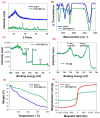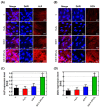Supermagnetic Sugarcane Bagasse Hydrochar for Enhanced Osteoconduction in Human Adipose Tissue-Derived Mesenchymal Stem Cells
- PMID: 32916934
- PMCID: PMC7557583
- DOI: 10.3390/nano10091793
Supermagnetic Sugarcane Bagasse Hydrochar for Enhanced Osteoconduction in Human Adipose Tissue-Derived Mesenchymal Stem Cells
Abstract
Hydrothermally carbonized sugarcane bagasse (SCB) has exceptional surface properties. Looking at the huge amount of SCB produced, its biocompatible nature, cheap-cost for carbonization, and its easy functionalization can give impeccable nano-biomaterials for tissue engineering applications. Herein, sugarcane bagasse was converted into hydrochar (SCB-H) by hydrothermal carbonation. The SCB-H produced was further modified with iron oxide (Fe3O4) nanoparticles (denoted as SCB-H@Fe3O4). Facile synthesized nano-bio-composites were characterized by SEM, HR-TEM, XRD, FT-IR, XPS, TGA, and VSM analysis. Bare Fe3O4 nanoparticles (NPs), SCB-H, and SCB-H@Fe3O4 were tested for cytocompatibility and osteoconduction enhancement of human adipose tissue-derived mesenchymal stem cells (hADMSCs). The results confirmed the cytocompatible and nontoxic nature of SCB-H@Fe3O4. SCB-H did not show enhancement in osteoconduction, whilst on the other hand, Fe3O4 NPs exhibited a 0.5-fold increase in the osteoconduction of hADMSCs. However, SCB-H@Fe3O4 demonstrated an excellent enhancement in osteoconduction of a 3-fold increase over the control, and a 2.5-fold increase over the bare Fe3O4 NPs. Correspondingly, the expression patterns assessment of osteoconduction marker genes (ALP, OCN, and RUNX2) confirmed the osteoconductive enhancement by SCB-H@Fe3O4. In the proposed mechanism, the surface of SCB-H@Fe3O4 might provide a unique topology, and anchoring to receptors of hADMSCs leads to accelerated osteogenesis. In conclusion, agriculture waste-derived sustainable materials like "SCB-H@Fe3O44" can be potentially applied in highly valued medicinal applications of stem cell differentiation.
Keywords: hADMSCs; hydrochar; hydrothermal carbonation; osteoconduction enhancement; sugarcane bagasse.
Conflict of interest statement
The authors declare no conflict of interest.
Figures







Similar articles
-
Surface functionalization of halloysite nanotubes with supermagnetic iron oxide, chitosan and 2-D calcium-phosphate nanoflakes for synergistic osteoconduction enhancement of human adipose tissue-derived mesenchymal stem cells.Colloids Surf B Biointerfaces. 2019 Jan 1;173:18-26. doi: 10.1016/j.colsurfb.2018.09.045. Epub 2018 Sep 20. Colloids Surf B Biointerfaces. 2019. PMID: 30261345
-
Synthesis of Magnetic Iron Oxide-Incorporated Cellulose Composite Particles: An Investigation on Antioxidant Properties and Drug Delivery Applications.Pharmaceutics. 2023 Feb 22;15(3):732. doi: 10.3390/pharmaceutics15030732. Pharmaceutics. 2023. PMID: 36986593 Free PMC article.
-
Amine-Functionalized Sugarcane Bagasse: A Renewable Catalyst for Efficient Continuous Flow Knoevenagel Condensation Reaction at Room Temperature.Molecules. 2017 Dec 24;23(1):43. doi: 10.3390/molecules23010043. Molecules. 2017. PMID: 29295557 Free PMC article.
-
Synthesis, characterization and antimicrobial properties of grafted sugarcane bagasse/silver nanocomposites.Carbohydr Polym. 2015 Jan 22;115:276-84. doi: 10.1016/j.carbpol.2014.08.052. Epub 2014 Sep 16. Carbohydr Polym. 2015. PMID: 25439896
-
Sugarcane bagasse: a biomass sufficiently applied for improving global energy, environment and economic sustainability.Bioresour Bioprocess. 2021 Sep 15;8(1):87. doi: 10.1186/s40643-021-00440-z. Bioresour Bioprocess. 2021. PMID: 38650274 Free PMC article. Review.
Cited by
-
Methylene Blue Dye Adsorption on Iron Oxide-Hydrochar Composite Synthesized via a Facile Microwave-Assisted Hydrothermal Carbonization of Pomegranate Peels' Waste.Molecules. 2023 Jun 2;28(11):4526. doi: 10.3390/molecules28114526. Molecules. 2023. PMID: 37299002 Free PMC article.
-
Regulation of Stem Cell Differentiation by Inorganic Nanomaterials: Recent Advances in Regenerative Medicine.Front Bioeng Biotechnol. 2021 Sep 30;9:721581. doi: 10.3389/fbioe.2021.721581. eCollection 2021. Front Bioeng Biotechnol. 2021. PMID: 34660552 Free PMC article. Review.
-
Regulation of base excision repair during adipogenesis and osteogenesis of bone marrow-derived mesenchymal stem cells.Sci Rep. 2023 Sep 29;13(1):16384. doi: 10.1038/s41598-023-43737-z. Sci Rep. 2023. PMID: 37773206 Free PMC article.
References
-
- Govindharaj M., Roopavath U.K., Rath S.N. Valorization of discarded Marine Eel fish skin for collagen extraction as a 3D printable blue biomaterial for tissue engineering. J. Clean. Prod. 2019;230:412–419. doi: 10.1016/j.jclepro.2019.05.082. - DOI
-
- Pandey A., Soccol C.R., Nigam P., Soccol V.T. Biotechnological potential of agro-industrial residues. I: Sugarcane bagasse. Bioresour. Technol. 2000;74:69–80. doi: 10.1016/S0960-8524(99)00142-X. - DOI
-
- Silveira M.H.L., Vanelli B.A., Corazza M.L., Ramos L.P. Supercritical carbon dioxide combined with 1-butyl-3-methylimidazolium acetate and ethanol for the pretreatment and enzymatic hydrolysis of sugarcane bagasse. Bioresour. Technol. 2015;192:389–396. doi: 10.1016/j.biortech.2015.05.044. - DOI - PubMed
-
- Kumari S., Das D. Biohythane production from sugarcane bagasse and water hyacinth: A way towards promising green energy production. J. Clean. Prod. 2019;207:689–701. doi: 10.1016/j.jclepro.2018.10.050. - DOI
Grants and funding
LinkOut - more resources
Full Text Sources

